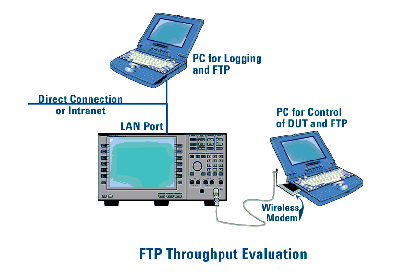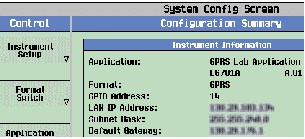FTP Throughput Test with the Data Channel
Last updated: December 2, 2008
This section is only applicable to the lab applications.
The Data Channel facilitates File Transfer Protocol (FTP) via the device. Typically this is done with a dial-up connection to an external PC using a GPRS PCMCIA modem or an external GPRS modem.
With appropriate evaluation tools on the Control PC, you can measure the throughput of the modem. Many commercial FTP programs provide detailed information on transfer speed.
To empirically measure the throughput, the performance of the network must be known. For this reason, it is not recommended to perform this evaluation while connected to the Internet. A Direct Connection or Intranet connection should be used instead.
A. Hardware Connections

Connect PC to LAN
Please consult with your IT department if you need assistance connecting your PC to the LAN. Refer to Protocol Logging for more information about setting up protocol logging.
Connect Test Set to LAN
Direct Connection
An alternate connection may be made using the Direct Connection method of connecting to the test set. This may be preferred, since it won't be necessary to characterize the Intranet for the throughput evaluation.
Make the following connections:
- Connect the Logging PC directly to the LAN port of the test set using a crossover cable.
- When setting up the test set and PCs (see B. Test Set and DUT Setup ), set the IP addresses of the PCs and test set to any valid IP addresses, as long as they are on the appropriate subnets.
B. Test Set and DUT Setup
Set Up Test Set

- Press the Sys Config key to display the System Config screen.
-
Use the
Instrument Setupsoftkey ( F1 ) to display the Instrument Setup menu. - Enter the IP address for the test set.
- Use the same menu to set the Subnet Mask.
- Use the same menu to set the Default Gateway.
- Press the Call Setup key to go to the Call Setup screen on the test set.
-
Select
Data Conn Typeand set the field toAuto. - Press the left More key to go to the second screen of the Control menu.
-
Select
DUT PDP Setupto open the DUT PDP Setup menu on the test set. -
Set the DUT's IP address (or the address of the controlling PC) in the DUT PDP Setup menu on the test set.
Note: The entered IP address must be on the same subnet as the test set.
C. Data Connection
In order to test the throughput of the DUT during active data transfer, the DUT and test set must first complete a successful PDP Context activation. With the test set this involves two steps:
First, the DUT must perform a GPRS attach.
- Connect the DUT to the RF IN/OUT port of the test set.
- Turn the DUT on and wait for Attached to appear in the Active Cell: field on the test set's front panel display. Some modems may need to attempt data transfer before it attaches to the test set. Sometimes the modem will attach if the number *99# is dialed.
For DUTs that don't perform a GPRS attach automatically, you may have to set the DUT to data mode.
Second, the DUT must request a PDP Context Activation.
- Use the DUT or the server to initiate transfers. The DUT will request an activation, an IP address will be assigned by the test set, and the PDP Context will be active.
- This can be observed by looking for "PDP Active" in the Active Cell Status: field.
You can also perform some measurements while using the Data Channel: